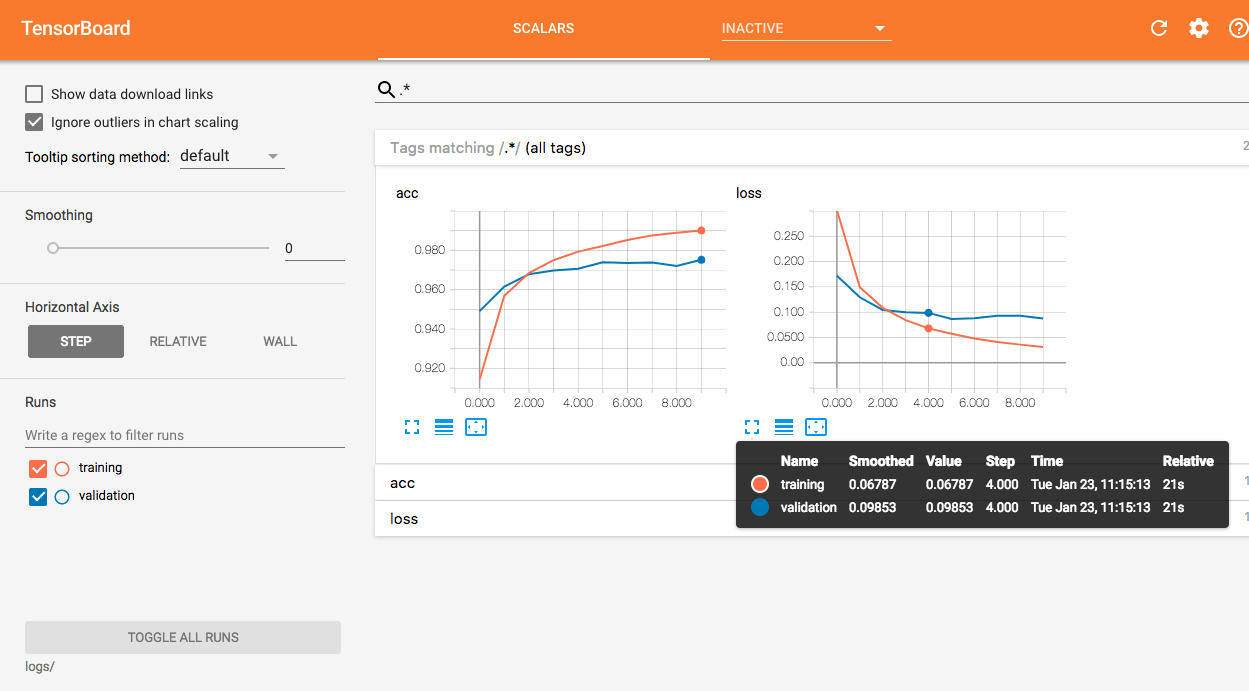参考https://stackoverflow.com/questions/47877475/keras-tensorboard-plot-train-and-validation-scalars-in-a-same-figure
tensorflow版本:1.13.1
keras版本:2.2.4
重新写一个TrainValTensorBoard继承TensorBoard。
import os
import tensorflow as tf
from keras.callbacks import TensorBoard
class TrainValTensorBoard(TensorBoard):
def __init__(self, log_dir='./logs', **kwargs):
# Make the original `TensorBoard` log to a subdirectory 'training'
training_log_dir = os.path.join(log_dir, 'training')
super(TrainValTensorBoard, self).__init__(training_log_dir, **kwargs)
# Log the validation metrics to a separate subdirectory
self.val_log_dir = os.path.join(log_dir, 'validation')
def set_model(self, model):
# Setup writer for validation metrics
self.val_writer = tf.summary.FileWriter(self.val_log_dir)
super(TrainValTensorBoard, self).set_model(model)
def on_epoch_end(self, epoch, logs=None):
# Pop the validation logs and handle them separately with
# `self.val_writer`. Also rename the keys so that they can
# be plotted on the same figure with the training metrics
logs = logs or {}
val_logs = {k.replace('val_', ''): v for k, v in logs.items() if k.startswith('val_')}
for name, value in val_logs.items():
summary = tf.Summary()
summary_value = summary.value.add()
summary_value.simple_value = value.item()
summary_value.tag = name
self.val_writer.add_summary(summary, epoch)
self.val_writer.flush()
# Pass the remaining logs to `TensorBoard.on_epoch_end`
logs = {k: v for k, v in logs.items() if not k.startswith('val_')}
super(TrainValTensorBoard, self).on_epoch_end(epoch, logs)
def on_train_end(self, logs=None):
super(TrainValTensorBoard, self).on_train_end(logs)
self.val_writer.close()
使用新的TrainValTensorBoard。
from keras.models import Sequential
from keras.layers import Dense
from keras.datasets import mnist
(x_train, y_train), (x_test, y_test) = mnist.load_data()
x_train = x_train.reshape(60000, 784)
x_test = x_test.reshape(10000, 784)
x_train = x_train.astype('float32')
x_test = x_test.astype('float32')
x_train /= 255
x_test /= 255
model = Sequential()
model.add(Dense(64, activation='relu', input_shape=(784,)))
model.add(Dense(10, activation='softmax'))
model.compile(loss='sparse_categorical_crossentropy', optimizer='adam', metrics=['accuracy'])
model.fit(x_train, y_train, epochs=10,
validation_data=(x_test, y_test),
callbacks=[TrainValTensorBoard(write_graph=False)])
